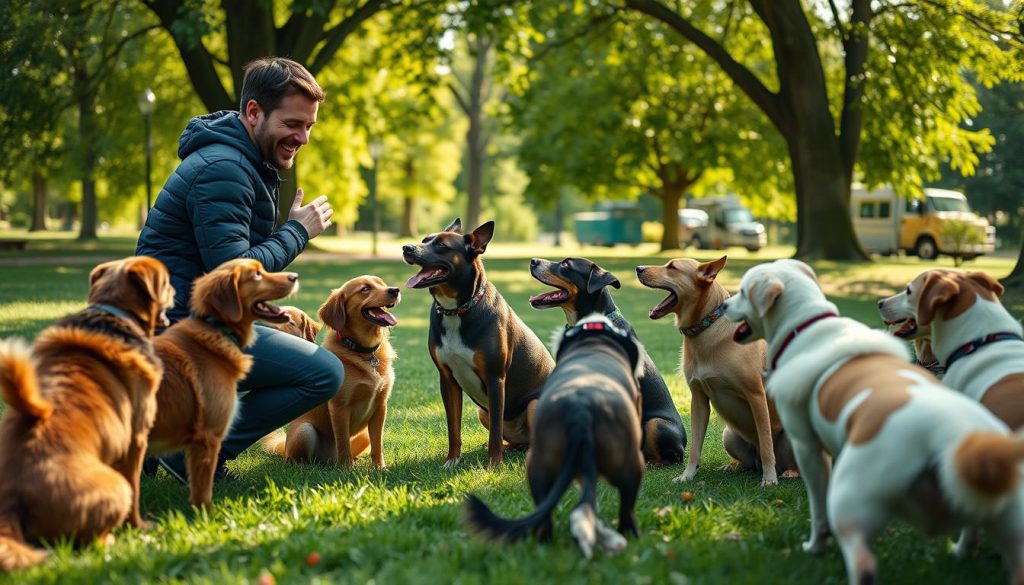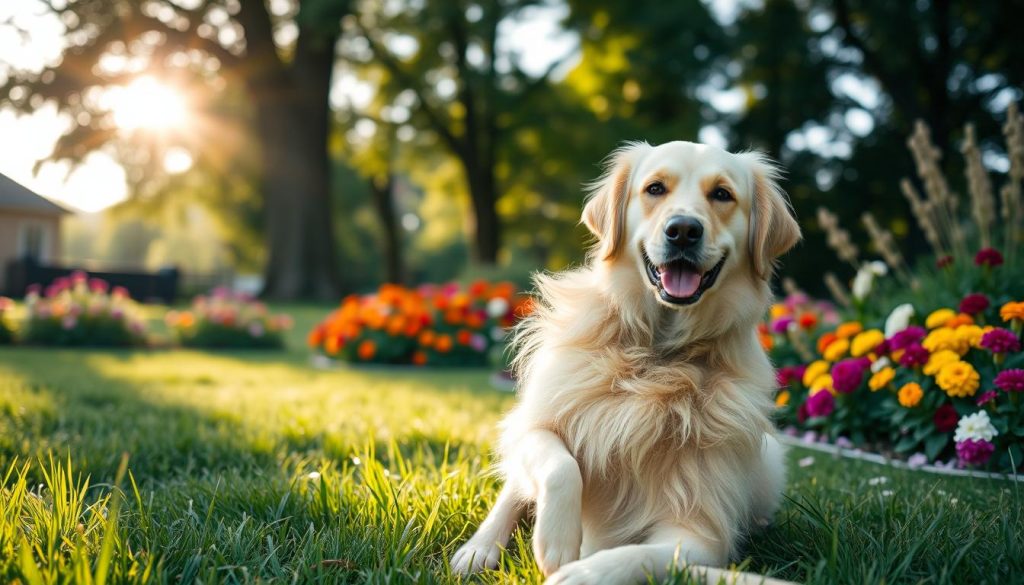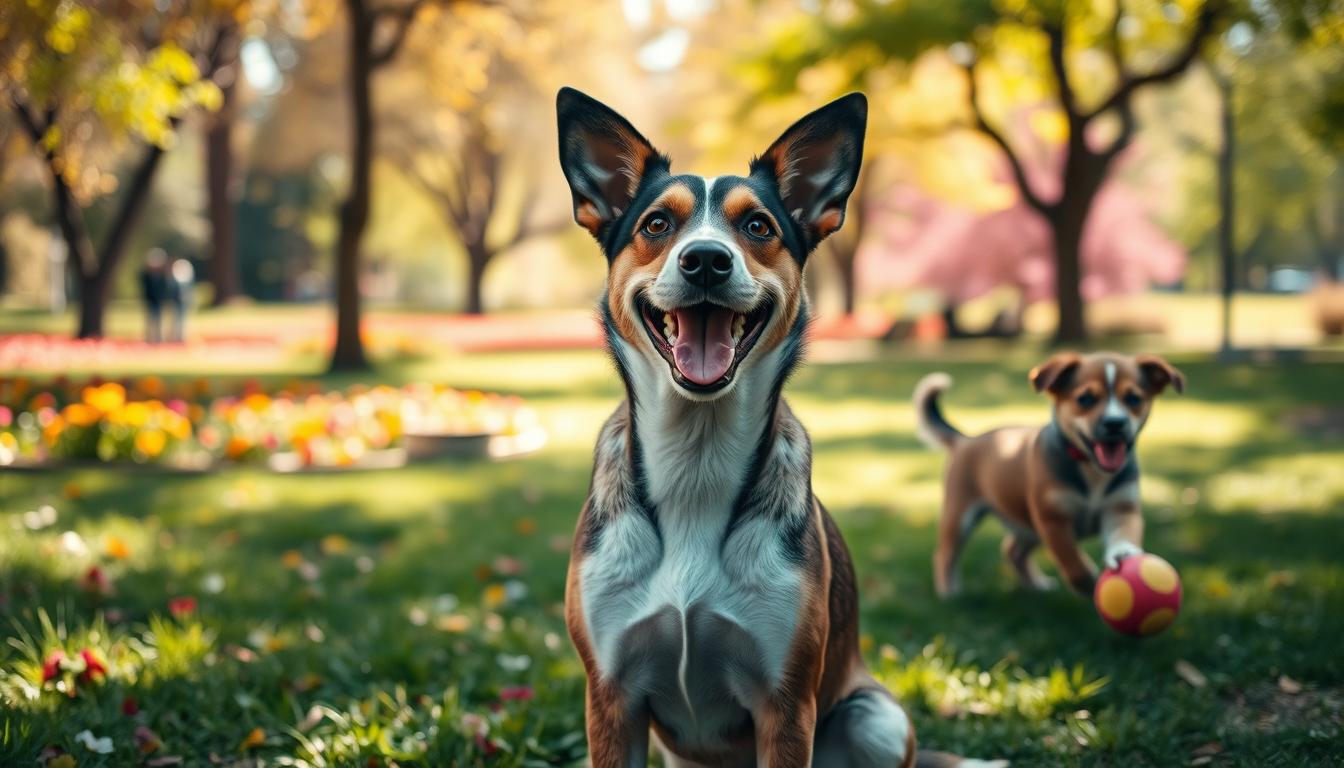Understanding dog behavior is key to a great relationship with your pet. This guide will help you understand your dog better. You’ll learn how to read their body language and use positive training methods.
This article is for both new and experienced dog owners. It offers practical tips to improve your bond with your dog. You’ll learn how to meet your dog’s needs and solve common problems.
Understanding Your Canine Companion
As a pet owner, learning about dog behavior and communication is crucial. It helps build a strong bond with your furry friend. By understanding your dog’s body language, you can know their needs, feelings, and likes. This knowledge lets you create a happy and enriching home for them.
Decoding Doggy Body Language
Dogs communicate in many ways, from their ears to their tail. A tucked tail might show fear or anxiety. But a wagging tail usually means they’re happy and excited.
Watching your dog’s face is also important. A wrinkled brow or a closed-mouth smile can tell you how they’re feeling. Learning these signs helps you meet their needs better and understand them deeper.
Exploring Breed-Specific Traits
Every dog breed has its own special traits that shape how they act and what they like. For example, herding breeds like Border Collies are great at following commands and enjoy structured activities. On the other hand, hounds like Bloodhounds are amazing at finding scents and are more independent.
Knowing your dog’s breed can help you tailor your care to fit their needs. This ensures a happy and fulfilling life together.
| Breed | Typical Behavioral Traits |
|---|---|
| Border Collie | Intelligent, eager to please, high-energy |
| Labrador Retriever | Friendly, loyal, adaptable |
| German Shepherd | Confident, protective, intelligent |
| Bulldog | Gentle, loyal, calm |
Dog Behavior Tips: Building a Strong Bond

Creating a strong bond with your dog is key to a happy pet. Simple strategies can help you connect deeply. Let’s look at how to build and keep this special bond.
Positive reinforcement is the heart of a strong bond. Rewarding your dog for good behavior with treats or praise strengthens your connection. It makes them trust and communicate better with you.
Socialization is also vital. Introduce your dog to new things in a positive way. This makes them confident and friendly, eager to be with you.
Spending quality time with your dog is crucial. Walks, playtime, or just cuddling on the couch strengthens your bond. The more you’re together, the stronger your connection will grow.
By using positive reinforcement, socialization, and quality time, you’ll build a strong bond with your dog. A strong bond means a happy, well-adjusted pet and a fulfilling relationship.
Positive Reinforcement Training Methods

Effective dog training is key for responsible pet owners. Positive reinforcement is the most humane and successful method. It rewards good behavior, building a strong bond between you and your dog.
Mastering Basic Commands
Positive reinforcement is great for teaching your dog basic commands like “sit,” “stay,” and “come.” Use treats, praise, or rewards when your dog does what you ask. This method is better than punishment and boosts your dog’s confidence and trust.
To start, use simple commands and make them harder as your dog gets better. Be patient, consistent, and adjust training to fit your dog’s needs. With effort, you’ll teach basic commands and have a well-behaved dog.
| Command | Description | Positive Reinforcement Technique |
|---|---|---|
| Sit | Instruct your dog to sit and remain in that position until released. | Reward your dog with a treat or praise when they sit on command. |
| Stay | Train your dog to remain in one spot until you give the release command. | Reward your dog with a treat or affection when they hold the stay position. |
| Come | Teach your dog to return to you when called, a crucial command for safety and obedience. | Praise and reward your dog with a treat when they come to you on command. |
Learning basic commands with positive reinforcement strengthens your bond and prepares you for any behavioral issues.
Addressing Common Behavioral Issues

As pet owners, we often face the challenge of managing our canine companions’ behavior. A well-trained and well-behaved dog brings immense joy to our lives. However, addressing common behavior problems like excessive barking and destructive chewing is crucial for a harmonious household. Understanding the causes and using positive reinforcement can effectively curb these behaviors and strengthen our bond with our furry friends.
Tackling Excessive Barking
Excessive barking can quickly become a source of frustration for pet owners. It often stems from a dog’s need for attention, boredom, or anxiety. To address this, provide your dog with ample exercise, mental stimulation, and positive reinforcement when they are quiet. Training methods like the “quiet” command and desensitizing your dog to triggers can manage this behavior.
Curbing Destructive Chewing
Destructive chewing can damage furniture, shoes, and other household items. It’s a natural instinct for dogs to explore their environment through their mouths. To curb this, provide appropriate chew toys and engage your dog in regular exercise and playtime. Positive reinforcement training can teach your dog to chew only on designated items.
| Behavior Issue | Possible Causes | Recommended Solutions |
|---|---|---|
| Excessive Barking |
|
|
| Destructive Chewing |
|
|
By addressing these common dog behavior problems with understanding, patience, and positive reinforcement, we can foster a harmonious relationship with our canine companions. This creates a more enjoyable living environment for all.
Socialization: Helping Your Dog Thrive
As a pet owner, you have a big responsibility. It’s to make sure your dog is well-socialized. Socializing your dog is key to their happiness and well-being. It helps them feel confident and ready for different social situations.
Start by introducing your dog to new things slowly and positively. Take them to puppy playdates, training classes, or walks in different areas. This helps them feel safe and comfortable, not scared.
Training your dog with positive reinforcement is also important. Teach them basic commands and reward them for good behavior. This builds trust and makes them more confident in social situations. Be patient and consistent as you help them grow.

